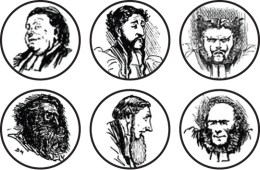You're more likely to see a beard in the pulpit today than at any time since the 1800s. But beards—especially among clergy—were once serious, symbolic matters. They separated East from West during the Great Schism, priests from laity during the Middle Ages, and Protestants from Catholics during the Reformation. Some church leaders required them; others banned them. To medieval theologians, they represented both holiness and sin. But historian Giles Constable says that rules on beards sound more forceful than they really were. Clergy (especially powerful ones) were likely to follow fashion in their day, too.

c. 195
Clement of Alexandria calls the beard "the mark of a man" and says "it is therefore unholy to desecrate the symbol of manhood." Many other church fathers made similar remarks about beardly manliness. But most early church clergy were either beardless or had a closely trimmed beard.

361
Roman Emperor Julian sports a beard to show his break with the shaven Christian emperors before him, and to mark his connection to pagan Roman religion.

c. 411
Euthymius says only men with a beard can enter his Judean Desert monastery, not boys "with female faces."

c. 475
A rule is made that "no cleric should grow long hair or shave his beard." It's very out of step with its time, and several copyists simply changed it to "No cleric should grow long hair or [a long] beard." It seems to have been ignored in its day but became widely referenced in the 1100s and 1200s.
816
The Council of Aachen requires monks to shave every 15 days (24 times a year). Other monastic communities adopt similar rules, though some only require a shave six or seven times a year. But hermits and other ascetics don't have to follow such rules and become famous for their long beards.

867
Reflecting growing tension between East and West, Pope Nicholas I writes to French bishops that Eastern church leaders were critical that "among us, clerics do not refuse to shave their beards."
868
Eneas, bishop of Paris, writes Liber Adversus Graecos (Book Against the Greeks), and complains that Eastern leaders "accused the Latins and Romans because they shave their beards."
868
Ratramnus, a Frankish Benedictine monk who would later inspire several figures in the Protestant Reformation, defends priestly shaving against Eastern church leaders who required beards. He argued that these beards may violate Paul's rule against long hair. And besides, "if it is a sin, or a transgression against the divine law, to cut the beard let [the Greeks] say why the prophet [Ezekiel] shaved his beard at the order of the Lord (Ezek. 5:1), why the Nazarenes [Nazarites] followed this custom, why finally the apostles did not fear this custom."
Early 1000s
Full beards come briefly back into style, but fall out of style by mid-century. This leads some older mid-century church leaders, nostalgic for beards, to associate shaving with immodesty. As one abbot wrote in 1043, the empire in Germany was besieged by "the shameful custom of the vulgar French … in the cutting of beards, in the shortening and deforming of clothing, execrable to modest eyes, and many other novelties." Half a century later, writers associated immodesty with beards, not shaving. One English Benedictine monk wrote, "Now almost all our fellow countrymen are crazy and wear little beards, openly proclaiming by such a token that they revel in filthy lusts like stinking goats."
1005
In England, the Canons of Edgar say no priest should "retain his beard for any time." A similar law is made in Northumbria three years later.
1031
The Council of Bourges unequivocally mandates "a shaved beard" for "all who minister within the Holy Church."

July 16, 1054
In what would mark the split between Eastern and Western Christianity, a French cardinal delivers a papal bull excommunicating the Patriarch of Constantinople. The document's list of "heresies" ends by citing the churches' division over beards: "Because they grow the hair on their head and beards, they will not receive in communion those who tonsure their hair and shave their beards following the decreed practice of the Roman Church."
c. 1060
Benedictine monk Otloh of St. Emmeram tells the story of a man accused of stealing a horse. A priest called to prepare the man for confession points out another "sin": "Although you are a layman and should go about with your beard unshaven in the manner of laymen, you have nevertheless, in contempt of divine law, shaved your beard just like a cleric." Seeking absolution, the man promises, "Never again shall a razor touch my beard." But a short time later he shaved, noting that his promise applied only to razors, not to sharp knives. "Divine vengeance swiftly followed such presumption," wrote Otloh. "For soon afterwards, he was captured by his enemies and deprived of sight when his eyes were gouged out."

Oct. 5, 1080
Attempting to Romanize the formerly Greek church in Sardinia, Pope Gregory VII notes that he has forced the archbishop to shave his beard "as the clergy of the whole Western church have had the custom of shaving the beard from the very origins of the Christian faith." All local clergy were ordered to do likewise.
1096
The archbishop of Rouen threatens to excommunicate anyone with a beard (or with long hair), not just clerics.

c. 1160
Abbot Burchard of Bellavaux writes Apologia de Barbis, a treatise on the biblical, theological, moral, social, and allegorical implications of beards. As a clerical monk, Burchard had a shaved face. And in an earlier letter he had (mostly by accident) insulted the "lay brothers" who wore beards. He wrote his Apologia, he said, to make amends and to explain why their beards were so great. But the work itself suggests that he thought beards were appropriate for lay brothers but inferior to the shaved faces of clerical monks (just as he thought their vocations were inferior).

c. 1170
Pope Alexander III bars clerical beards. "Although the canonical rules prohibiting beards and requiring shaving remained in force, and were indeed reenacted throughout the Middle Ages, they were widely disregarded, especially by the higher clergy," Giles Constable wrote in his definitive history of medieval beards. "Even long beards seem to have been fashionable at the papal court at the time of the Reformation."
1531
Piero Valeriano Bolzani writes Pro Sacerdotum Barbis, a defense of priestly beards, after Pope Clement VII (who grew a beard to mourn the sack of Rome in 1527) threatened to renew calls for clerical shaving.
July 6, 1535
At his beheading, Sir Thomas More reportedly set his beard away from his neck on the chopping block. "My beard has not been guilty of treason," he said. "It would be an injustice to punish it."
1535
Henry VIII taxes beards.

1547
Archbishop of Canterbury Thomas Cranmer begins to grow a beard, ostensibly to mark his mourning of the death of King Henry VIII, but also to signal a break with the (beardless) Catholic clergy.

1830
Pastor George Trask of Fitchburg, Massachusetts, preaches against the "vain" (and rare) beard of congregant Joseph Palmer, and demands that he shave it off. When Trask denies Palmer Communion, Palmer grabs the chalice and drinks it anyway, shouting, "I love my Jesus as well, and better than any of you!" After he was jailed for fighting off attackers who tried to cut off his beard, Palmer (and his beard) became a New England cause célèbre.

March 5, 1864
Punch runs a series of caricatures of the different kinds of Anglican clergy beards in the UK, noting that they're not found among Catholics or dissenting Christians (like Baptists and Congregationalists). "The Barbine Movement is altogether the property of the Establishment," the satirical paper wrote. "No Popish priest in this country has entrenched upon this prerogative. The Dissenters shave in gloomy silence, leaving this noble field of ecclesiastical adornment to the Clergy of the Establishment." (CT sister publication Out of Ur ran a similar, contemporary taxonomy of beards in February.)
1942
"We have now for many centuries triumphed over nature to the extent of making certain secondary characteristics of the male (such as the beard) disagreeable to nearly all the females—and there is more in that than you might suppose." —C. S. Lewis, The Screwtape Letters.
c. 1970
Several Christian colleges bar beards, especially among faculty, over their association with protest movements.

July 21, 2013
Saddleback Church hosts a contest for "Most Magnificent Beard and Most Pathetic Beard" as Duck Dynasty's barbate Phil Robertson and his beardless son, Alan, preach.























